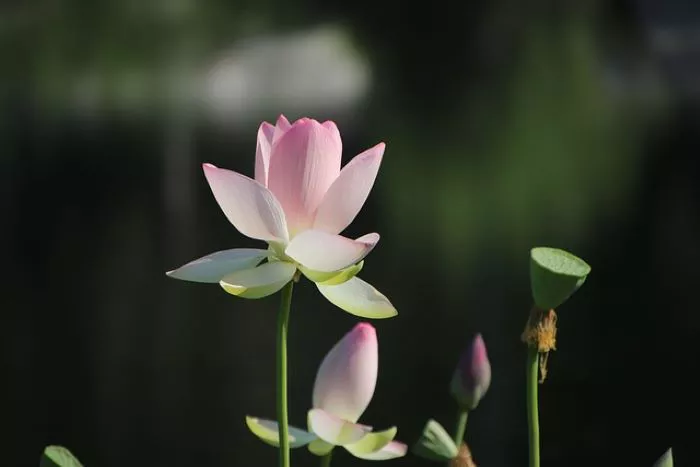The lotus flower, known scientifically as Nelumbo nucifera, is a remarkable aquatic plant that has fascinated people for centuries. Its unique blooming process is not only beautiful but also symbolic of purity and spiritual enlightenment. Understanding how the lotus flower blooms involves exploring its growth cycle, environmental needs, and the intricate mechanisms that allow it to rise above the water’s surface. This article provides a detailed overview of how lotus flowers bloom.
The Life Cycle of the Lotus Flower
The life cycle of the lotus flower consists of several stages, from seed germination to flowering. Each stage is crucial for the overall development of the plant.
Seed Germination: The journey begins with the lotus seed, which is known for its hard outer shell. To germinate, the seed must first undergo a process called scarification, where the outer layer is gently scraped or sanded to allow moisture to penetrate. After scarification, the seeds are soaked in warm water for 24 to 48 hours. This soaking helps soften the seed coat and initiates the germination process.
Seedling Development: Once the seeds have absorbed enough moisture, they begin to sprout. The first sign of growth is the emergence of a small shoot from the seed. This shoot will eventually develop into the stem of the lotus plant. As the seedling grows, it develops leaves that float on the water’s surface. These leaves are large, round, and have a waxy coating that prevents water from accumulating on them.
Root Development: The lotus plant develops a strong root system anchored in the muddy substrate at the bottom of the water body. The roots are essential for nutrient uptake and stability. They allow the plant to draw essential minerals and nutrients from the soil, promoting healthy growth.
Environmental Requirements for Blooming
Lotus flowers require specific environmental conditions to bloom successfully. These conditions include water depth, sunlight, and temperature.
Water Depth: Lotus plants thrive in shallow water, typically ranging from 12 to 24 inches deep. The water depth must be sufficient to keep the roots submerged while allowing the leaves and flowers to rise above the surface. Too much water can hinder growth, while too little can expose the roots to air.
Sunlight: Lotus flowers require full sunlight for optimal blooming. They need at least six hours of direct sunlight each day. Sunlight is vital for photosynthesis, which provides the energy necessary for growth and flowering. Inadequate sunlight can result in weak plants and fewer blooms.
Temperature: Lotus plants prefer warm temperatures, typically between 70°F and 90°F (21°C to 32°C). They are sensitive to cold weather and may not bloom if temperatures drop significantly. In colder climates, it is essential to protect the plants during winter to ensure they survive and bloom in the spring.
The Blooming Process
The blooming process of the lotus flower is a fascinating phenomenon that occurs in several stages. This process is influenced by environmental conditions and the plant’s internal mechanisms.
Bud Formation: As the plant matures, it produces flower buds that emerge from the water. These buds are initially submerged and gradually rise to the surface. The formation of buds typically occurs in late spring or early summer when environmental conditions are optimal.
Opening of the Flower: The lotus flower opens in the morning, usually around sunrise. The petals unfurl in a graceful manner, creating a stunning display. This opening process can take several hours and is influenced by temperature and sunlight. The flower may close in the evening and reopen the next day.
Pollination: Once the flower is fully open, it attracts pollinators such as bees and butterflies. The lotus flower is hermaphroditic, meaning it has both male and female reproductive organs. Pollination occurs when pollen from the stamens (male parts) is transferred to the pistil (female part). This process is essential for seed production.
Seed Development: After successful pollination, the flower begins to fade, and the seed pod develops. The seed pod is distinctive, with a unique shape that resembles a showerhead. It contains multiple seeds, which will eventually disperse to produce new lotus plants.
Symbolism of Blooming
The blooming of the lotus flower carries profound symbolism in various cultures. It represents purity, spiritual awakening, and resilience.
Purity: The lotus blooms beautifully above muddy waters, symbolizing purity and the ability to rise above challenges. This characteristic has made the lotus a powerful symbol in many spiritual traditions.
Spiritual Awakening: In Buddhism, the lotus flower is often associated with enlightenment. The journey of the lotus from the depths of murky waters to a radiant bloom signifies the path to spiritual awakening and self-realization.
Resilience: The lotus flower’s ability to thrive in challenging conditions serves as a reminder of resilience. It encourages individuals to overcome obstacles and emerge stronger.
Conclusion
The blooming process of the lotus flower is a captivating journey that reflects the beauty of nature and the resilience of life. From seed germination to the emergence of stunning blooms, each stage of growth is essential for the plant’s development. Understanding how lotus flowers bloom provides insight into their ecological significance and cultural symbolism. As we admire the beauty of the lotus, we are reminded of the deeper meanings it holds, inspiring us to embrace purity, resilience, and spiritual growth in our own lives.


